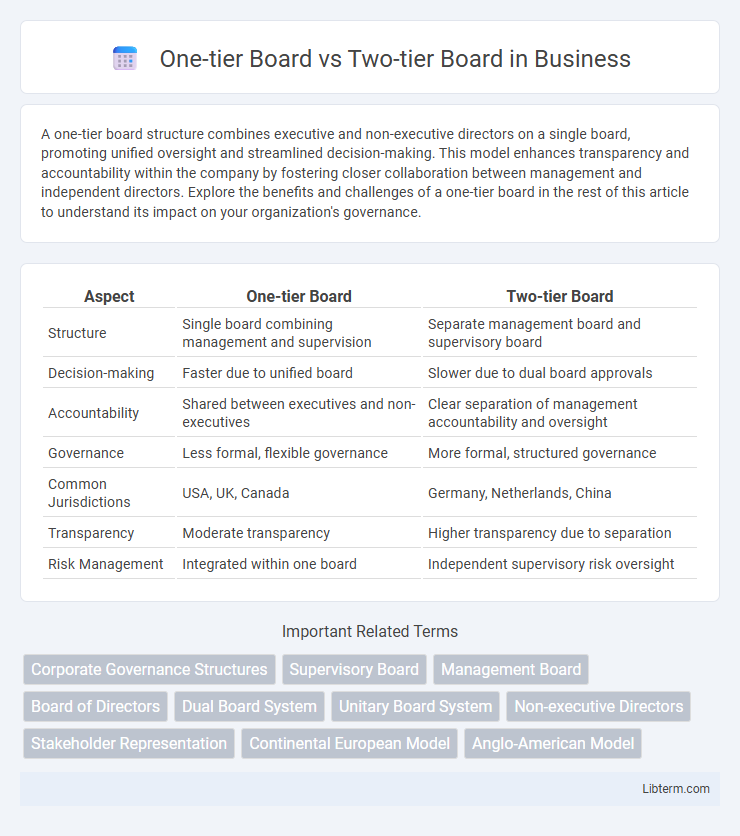A one-tier board structure combines executive and non-executive directors on a single board, promoting unified oversight and streamlined decision-making. This model enhances transparency and accountability within the company by fostering closer collaboration between management and independent directors. Explore the benefits and challenges of a one-tier board in the rest of this article to understand its impact on your organization's governance.
Table of Comparison
| Aspect | One-tier Board | Two-tier Board |
|---|---|---|
| Structure | Single board combining management and supervision | Separate management board and supervisory board |
| Decision-making | Faster due to unified board | Slower due to dual board approvals |
| Accountability | Shared between executives and non-executives | Clear separation of management accountability and oversight |
| Governance | Less formal, flexible governance | More formal, structured governance |
| Common Jurisdictions | USA, UK, Canada | Germany, Netherlands, China |
| Transparency | Moderate transparency | Higher transparency due to separation |
| Risk Management | Integrated within one board | Independent supervisory risk oversight |
Introduction to Corporate Board Structures
A one-tier board structure combines executive and non-executive directors into a single board responsible for both management and supervision, commonly used in countries like the United States and the United Kingdom. In contrast, a two-tier board separates the management board, which handles daily operations, from a supervisory board overseeing broader strategic decisions and monitoring, a system prevalent in Germany and the Netherlands. This structural distinction influences corporate governance, accountability, and decision-making processes within multinational corporations.
Defining One-tier Board System
A One-tier Board system consolidates management and supervisory functions within a single board composed of both executive and non-executive directors, facilitating direct communication and faster decision-making. This structure enhances accountability by integrating strategic oversight with operational management, commonly adopted in Anglo-American corporate governance models. The unified board promotes transparency and streamlined governance, contrasting with the Two-tier Board system which separates supervisory and management roles into distinct boards.
Defining Two-tier Board System
The two-tier board system separates management and supervisory functions into distinct bodies: a management board responsible for daily operations and a supervisory board overseeing strategic direction and compliance. This structure enhances corporate governance by providing checks and balances, with the supervisory board appointed by shareholders to monitor executive decisions. Common in countries like Germany and the Netherlands, the two-tier system contrasts with the one-tier board by promoting independent oversight and stakeholder representation.
Key Differences Between One-tier and Two-tier Boards
One-tier boards integrate executive and non-executive directors into a single group, fostering direct communication and unified decision-making, whereas two-tier boards separate management and supervisory functions into distinct bodies, enhancing oversight and reducing conflicts of interest. In one-tier systems, typically found in Anglo-American jurisdictions like the US and UK, the board collectively formulates strategy and monitors performance, while two-tier structures, common in Germany and the Netherlands, consist of a management board handling daily operations and a supervisory board overseeing management. The key difference lies in the degree of separation of powers and accountability mechanisms, impacting corporate governance, transparency, and stakeholder representation.
Advantages of One-tier Board Structure
The one-tier board structure enhances decision-making efficiency by combining executive and non-executive directors in a single body, facilitating better communication and faster implementation of strategies. This integrated governance model improves accountability through direct oversight of management by board members actively involved in daily operations. Companies adopting one-tier boards often experience stronger alignment between management and shareholder interests, promoting cohesive corporate direction and enhanced performance.
Benefits of Two-tier Board Structure
The two-tier board structure enhances corporate governance by clearly separating supervisory and management functions, leading to improved oversight and accountability. It allows non-executive directors to monitor management performance independently, reducing conflicts of interest and promoting transparency. This structure is prevalent in countries like Germany and the Netherlands, where it supports stakeholder engagement and long-term strategic focus.
Regulatory and Geographic Preferences
One-tier boards, prevalent in the United States and the United Kingdom, combine executive and non-executive directors on a single board, aligning with regulatory frameworks favoring streamlined decision-making and shareholder engagement. Two-tier boards, common in Germany, the Netherlands, and other continental European countries, separate management and supervisory functions into distinct boards, complying with regulatory mandates for enhanced oversight and stakeholder representation. Geographic preferences often reflect these governance traditions, with Anglo-American markets favoring the one-tier model for flexibility and efficiency, while European jurisdictions emphasize the two-tier structure for accountability and regulation compliance.
Impact on Corporate Governance
One-tier boards consolidate executive and non-executive directors into a single body, enhancing direct communication and faster decision-making, which can improve corporate governance efficiency. Two-tier boards separate supervisory and management functions, promoting greater oversight and reducing conflicts of interest, thereby strengthening accountability and transparency. The choice between these structures significantly influences board independence, stakeholder engagement, and governance mechanisms within a corporation.
Challenges and Criticisms of Each Model
The one-tier board model faces challenges such as potential conflicts of interest due to the merging of management and supervisory roles, which can limit independent oversight and reduce accountability. In contrast, the two-tier board system, while enhancing governance through clear separation, often suffers from slower decision-making processes and increased complexity, potentially leading to communication barriers between management and supervisory boards. Both models encounter criticism regarding their effectiveness in balancing control, transparency, and agility within corporate governance frameworks.
Choosing the Right Board Structure for Your Organization
Choosing the right board structure depends on your organization's size, regulatory environment, and governance goals. One-tier boards combine executive and non-executive directors, promoting streamlined decision-making and faster communication, suitable for smaller or less complex companies. Two-tier boards separate supervisory and management functions, enhancing oversight and checks and balances, which is often preferred in larger, regulated, or publicly traded organizations.
One-tier Board Infographic

 libterm.com
libterm.com